Mineralogical and Gemological Characteristics and Color Genesis of Zibai Jade
Abstract
1. Introduction
2. Materials and Methods
3. Results
3.1. Conventional Gemological Properties
3.2. X-Ray Powder Diffraction (XRD)
3.3. Microstructural Characteristics
3.4. Backscattered Electron (BSE) Images
3.5. EPMA
3.6. UV-Vis
3.7. XRF
3.8. FTIR
4. Discussion
4.1. Mineralogical Characteristics and Formation Mechanism
4.2. Colouration Mechanism
5. Conclusions
- (1)
- Zibai Jade exhibits a heterogeneous color distribution, featuring a base of light green and yellowish-green tones along with characteristic surface occurrences such as dark green patches, fibrous green inclusions, white patches, white veinlets, and black-core-with-green-rim textures. The sample has a refractive index of 1.71–1.72 and a specific gravity of 3.40–3.54, shows no reaction to ultraviolet fluorescence, and appears red under the Chelsea filter.
- (2)
- The jade is primarily composed of hydrogrossular, which constitutes more than 82% of the matrix. Minor minerals include diopside, vesuvianite, chlorite, uvarovite, calcite, and chromite.
- (3)
- The coloration of the jade is primarily governed by the combined effects of iron and chromium elements. The emerald-green spots consist of uvarovite, while the dark green spots are composed of diopside, hydrogrossular, and chlorite, with diopside being partially altered to chlorite. The fibrous green inclusions are predominantly formed by chlorite and Cr-bearing grossular. The white patches and veinlets are composed of carbonate minerals, predominantly calcite. The “black dot with a green ring” texture is mainly constituted by chromite and uvarovite.
- (4)
- The formation of the jade involved three mineralization stages: deposition of a carbonate protolith, high-temperature metasomatism, and retrograde alteration. The synergistic interaction of granodiorite-derived Si-Al-rich fluids and ultramafic-derived Cr-rich fluids with the carbonate protolith was key to the development of the mineral assemblage. These processes resulted in the development of Zibai Jade, which exhibits a dense texture and attractive coloration.
Author Contributions
Funding
Institutional Review Board Statement
Informed Consent Statement
Data Availability Statement
Acknowledgments
Conflicts of Interest
References
- Zhao, D.T. Analysis of Natural Jade Resources in Qinghai Province. J. Qinghai Univ. 2012, 30, 66–68+75. [Google Scholar] [CrossRef]
- Li, Z.C. Garnet. Zhu Bao 1991, 2, 16–19+1. [Google Scholar]
- Bloise, A.; Barrese, E.; Apollaro, C.; Miriello, D. Flux growth and characterization of Ti-and Ni-doped forsterite single crystals. Crystal Research and Technology. J. Exp. Ind. Crystallogr. 2009, 44, 463–468. [Google Scholar]
- Zheng, Y.L.; Chen, M.H.; Sun, R.Z.; Liu, J.; Wang, C. Gemological and Mineralogical Characteristics of Pink Hydrogrossular. J. Gems Gemmol. 2023, 25, 14–20. [Google Scholar] [CrossRef]
- Hsu, T.; Kennedy, L.; Choudhary, G. Synthetics and Simulants. Gems Gemol. 2024, 60, 260–265. [Google Scholar]
- Chilstrom, C. Large Star Emerald. Gems Gemol. 2015, 51, 334–335. [Google Scholar]
- Xu, Y.R. Study on Gemological and Mineralogical Characteristics of Hydrogrossular Jade and Vesuvianite Jade from the Tawmaw Area, Myanmar. Master’s Thesis, China University of Geosciences (Beijing), Beijing, China, 2014. [Google Scholar]
- Lu, R. Three Similar-Appearing Green Stones: Jadeite, Omphacite, and Hydrogrossular. Gems Gemol. 2011, 47, 52–53. [Google Scholar]
- Liu, H.; Ruan, Q.F.; Qiu, Z.H.; Lei, T.; Zhu, M. Mineralogical Characteristics and Color Genesis of Vesuvianite Jade from Hanzhong, Shaanxi Province. Miner. Petrol. 2023, 43, 1–9. [Google Scholar] [CrossRef]
- Zhang, Y.J.; Liang, W.T.; Luo, X.R.; Dong, Y.; Zhang, G. Geochemical Characteristics and Petrogenetic Significance of Biotite from Guangtoushan Rock Masses, Qinling Orogenic Belt. Miner. Petrol. 2015, 35, 100–108. [Google Scholar] [CrossRef]
- Song, X.W.; Hou, M.T.; Chen, R.Y. Division of Metallogenic Provinces (Belts) in Shaanxi Province. Northwest. Geol. 2004, 3, 29–42. [Google Scholar]
- Wang, F.; Li, J.Y.; Fu, C.; Zhang, Y.Q.; Chen, Y. Geological Characteristics and Gold Prospecting Potential of the Pogenjiao Silver-Lead Deposit in Taibai County, Shaanxi Province. Acta Geol. Sichuan 2017, 37, 396–399+420. [Google Scholar]
- Wang, Z.M.; Xiao, H.L.; Wang, D.S.; Xie, H.P. Geological Characteristics and Metallogenic Conditions of the Xigou Copper Deposit in Liuba County, Shaanxi Province. Shaanxi Geol. 2018, 3, 15–18. [Google Scholar]
- Liu, H. Gemological and Mineralogical Characteristics and Genetic Study of Hanzhong Vesuvianite Jade from Shaanxi Province. Master’s Thesis, Guilin University of Technology, Guilin, China, 2022. [Google Scholar]
- Bai, W.L.; Yang, Z.L.; Liu, Z.H.; Xie, F. Application of Gully-Soil Geochemical Survey in Gold Exploration of Liuba County, Shaanxi Province. Miner. Resour. Geol. 2017, 31, 780–784. [Google Scholar]
- Fang, Z.; Wang, X.M. Mineralogical Study of the Jade “Budaweng” Resembling Jadeite. Geol. Chem. Miner. 2002, 1, 7–10+27. [Google Scholar]
- Liang, T.; Liu, Y.X. Comparative Study of Color Characteristics of Yunnan Emerald and Colombian Emerald. J. Xi’an Eng. Univ. 1998, 3, 43–47. [Google Scholar]
- Tian, H.S.; Zhao, Y.J. Discovery and Preliminary Study of Chromium-rich Vesuvianite from Yaoshan, Jinan. Shandong Geol. 1992, 2, 115–118. [Google Scholar]
- Wu, H.Q. Study on Gemological Characteristics and Color Genesis of Orange-Red Series Garnet. Master’s Thesis, China University of Geosciences, Beijing, China, 2016. [Google Scholar]
- Li, M.Y. Gemological Characteristics and Color Genesis of Philippine “Dushan Jade”. Master’s Thesis, China University of Geosciences, Beijing, China, 2019. [Google Scholar] [CrossRef]
- Liu, J.; Yang, M.X.; Di, J.R.; He, C. Spectroscopic Study of Uvarovite in Anorthite Jade. Spectrosc. Spect. Anal. 2018, 38, 1758–1762. [Google Scholar]
- Qu, M.W.; Zhong, Y.; Shen, X.T. Gemological Characteristics of Zambian Purplish-Red to Brownish-Red Garnets. J. Gems Gemmol. 2021, 23, 20–28. [Google Scholar] [CrossRef]
- Schoenitz, M.; Navrotsky, A. Enthalpy of Formation of Katoite Ca3Al2[(OH)4]3: Energetics of the Hydrogarnet Substitution. Am. Mineral. 1999, 84, 389–395. [Google Scholar] [CrossRef]
- Geiger, C.A.; Dachs, E.; Benisek, A. Thermodynamic Behavior and Properties of Katoite (Hydrogrossular): A Calorimetric Study. Am. Mineral. 2012, 97, 1252–1255. [Google Scholar] [CrossRef]
- Panikorovskii, T.L.; Krivovichev, S.V.; Galuskin, E.V.; Shilovskikh, V.V.; Mazur, A.S.; Bazai, A.V. Si-Deficient, OH-Substituted, Boron-Bearing Vesuvianite from Sakha-Yakutia, Russia: A Combined Single-Crystal, 1H MAS-NMR and IR Spectroscopic Study. Eur. J. Miner. 2016, 28, 931–941. [Google Scholar] [CrossRef]
- Liu, X. Study on Gemological and Mineralogical Characteristics of Henan Dushan Jade. Master’s Thesis, Hebei GEO University, Shijiazhuang, China, 2022. [Google Scholar] [CrossRef]
- Yong, C.Y. Study on Gemological and Mineralogical Characteristics of Mexican Strawberry-Red Grossular Garnet. Master’s Thesis, China University of Geosciences, Beijing, China, 2019. [Google Scholar] [CrossRef]
- Lu, H.H.; Pan, L.; Han, S.H.; Hao, F. Study on the Infrared Spectroscopy of Methyl and Chloromethyl Substituted Silatranes. Elastomer 1998, 2, 24–26. [Google Scholar] [CrossRef]
- Ren, H.; Zheng, Y.Y.; Wu, S. Application of Short-Wave Infrared Spectroscopy of Chlorite in Exploration of the Demingding Mo-Cu Deposit, Tibet. In Proceedings of the 9th National Conference on Metallogenic Theory and Prospecting Methods, Wuhan, China, 13–15 December 2019; p. 444. [Google Scholar] [CrossRef]
- Jia, R.X. Geological and Geochemical Study of the Gejiu Tin Ore Concentration Area in Yunnan Province. Ph.D. Thesis, Northwest University, Xi’an, China, 2005. [Google Scholar]
- Shi, R.D.; Yang, J.S.; Wang, X.B.; Zheng, X.H. Discovery and Significance of Rodingite in the Derni Copper Mining Area. In Proceedings of the 4th National Conference of Young Geologists, Beijing, China, 15–18 October 1999; pp. 113–120. [Google Scholar]
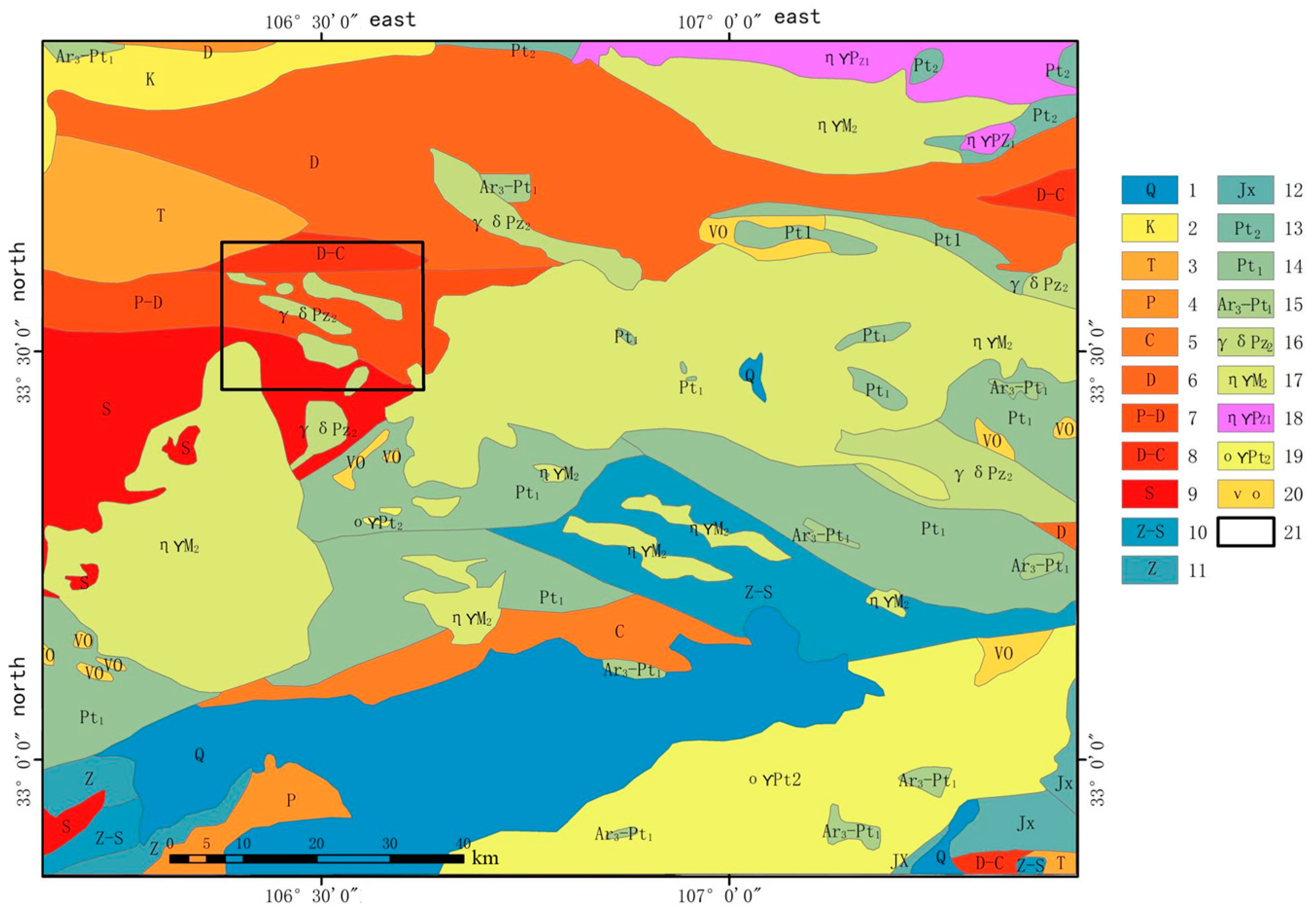
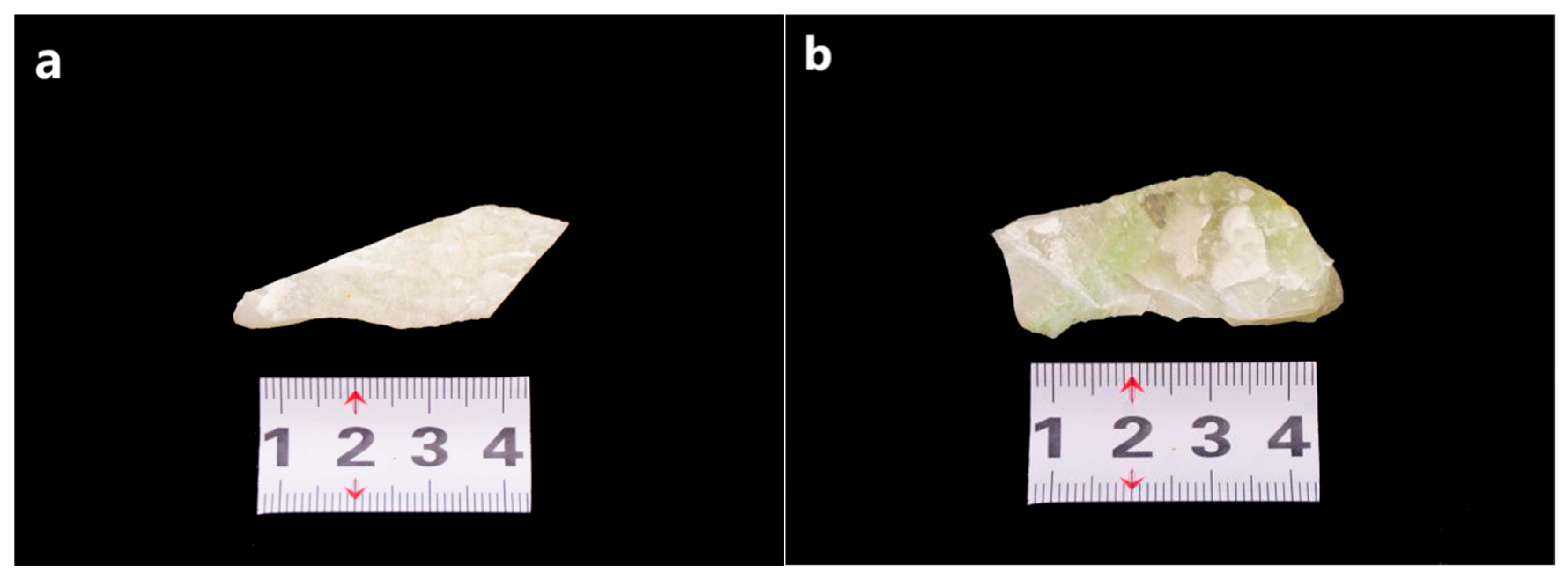
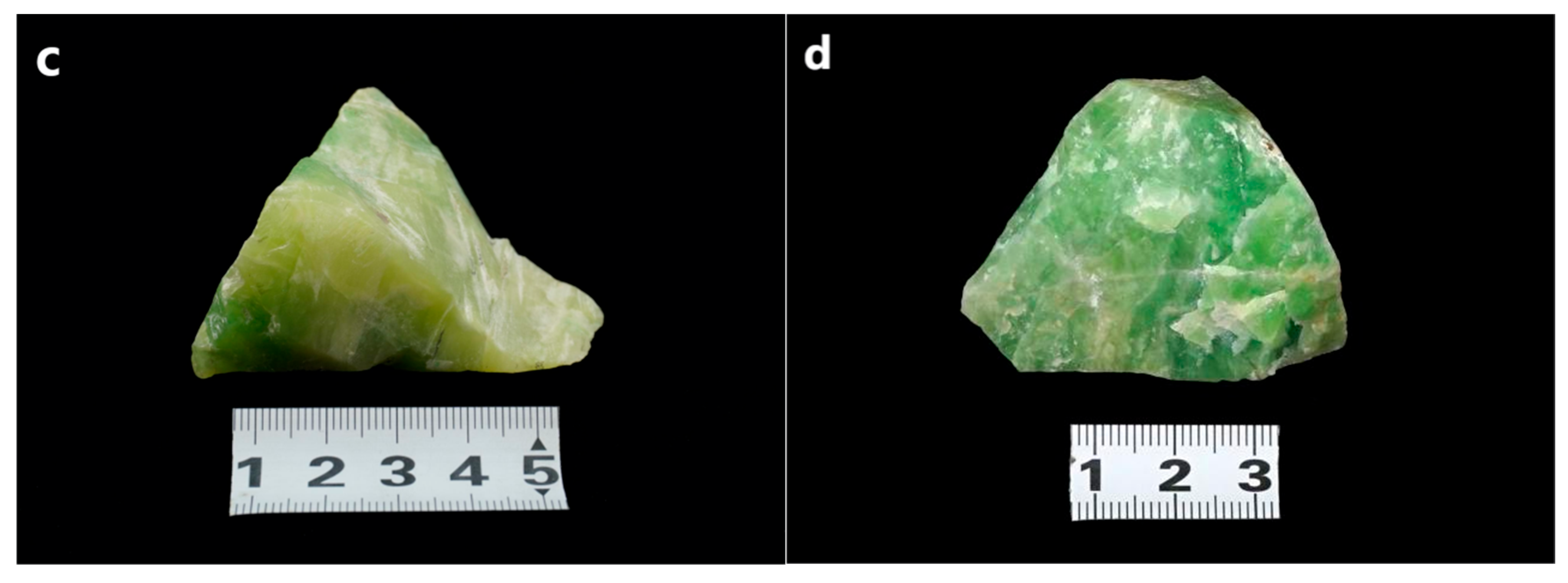

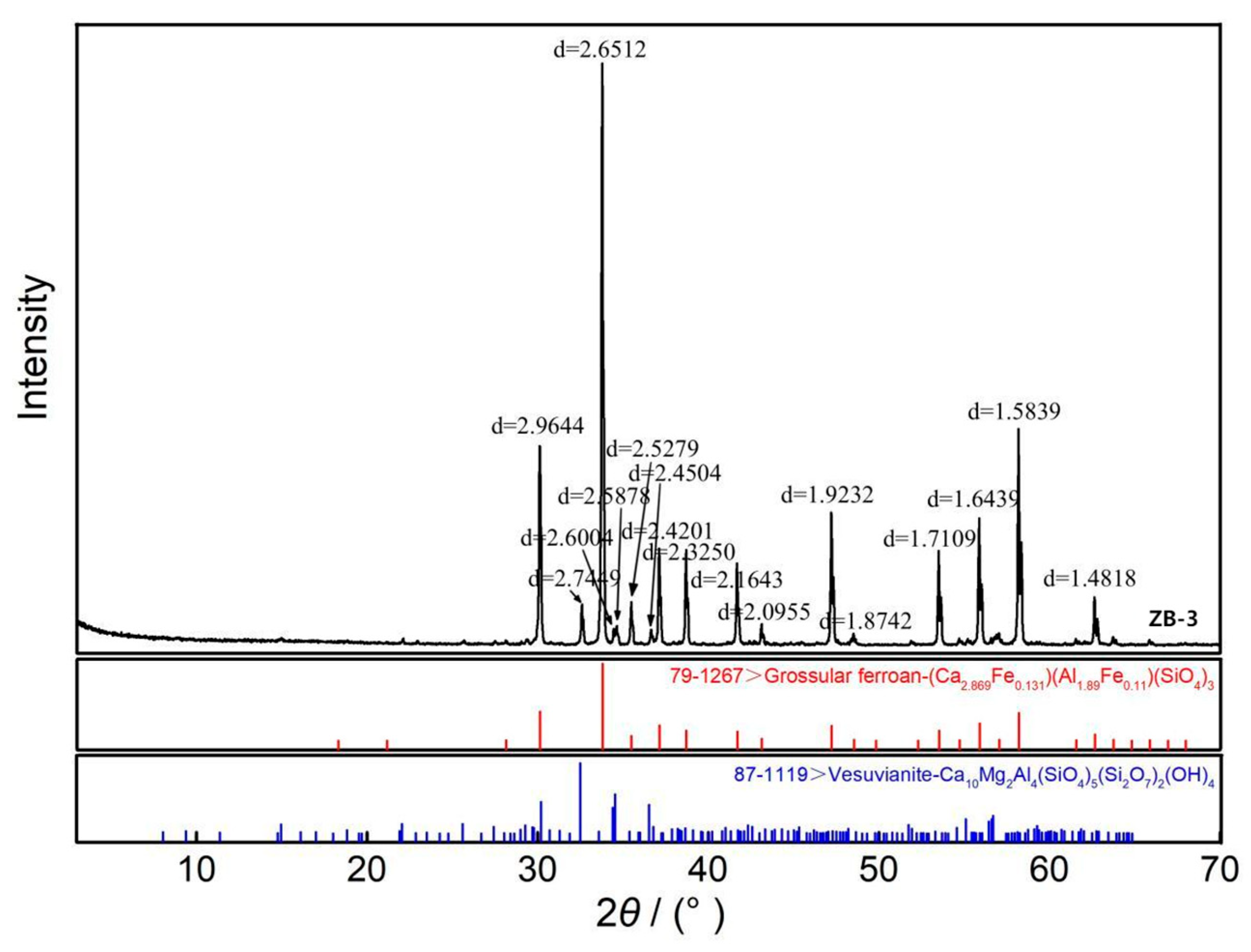
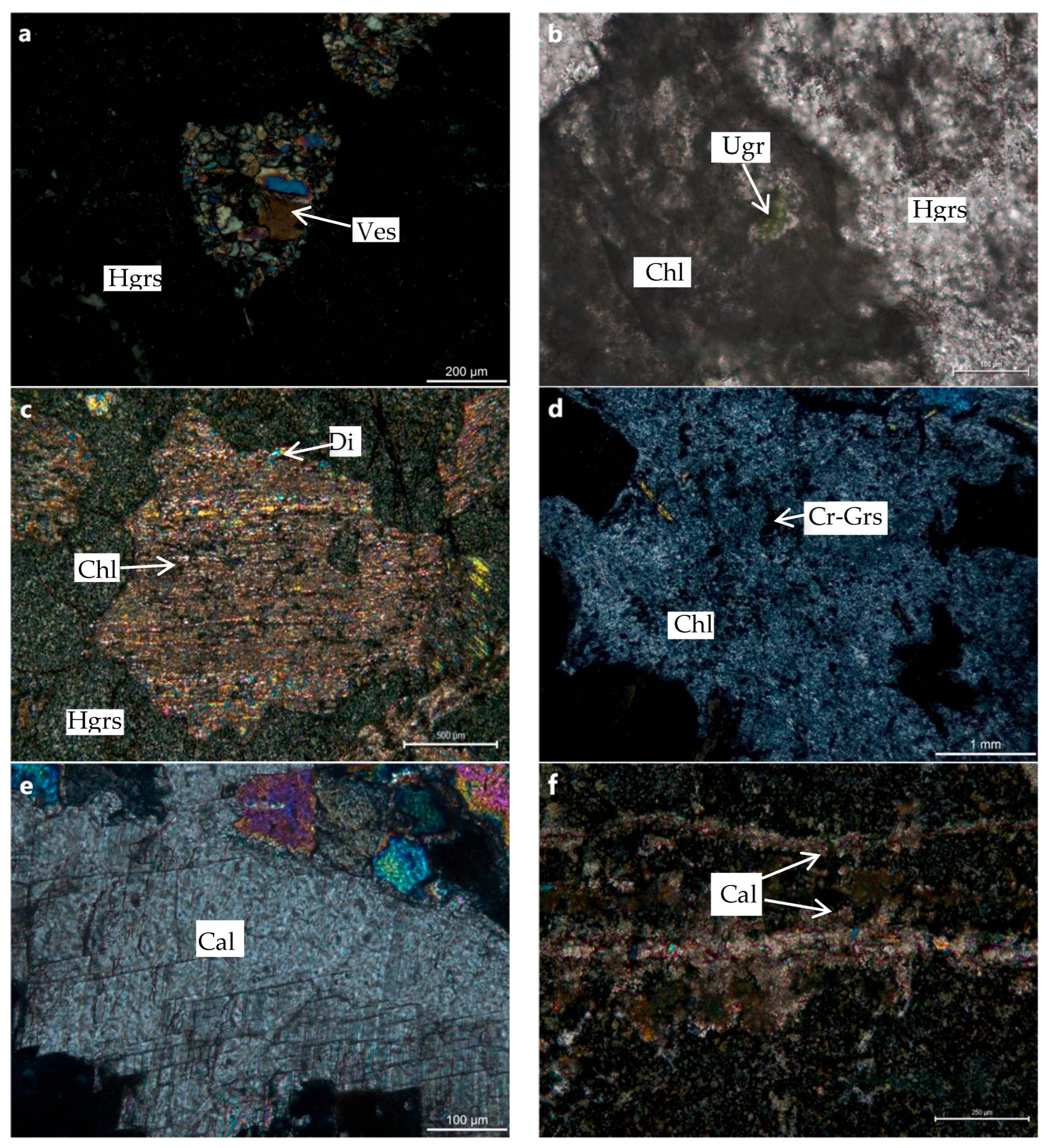
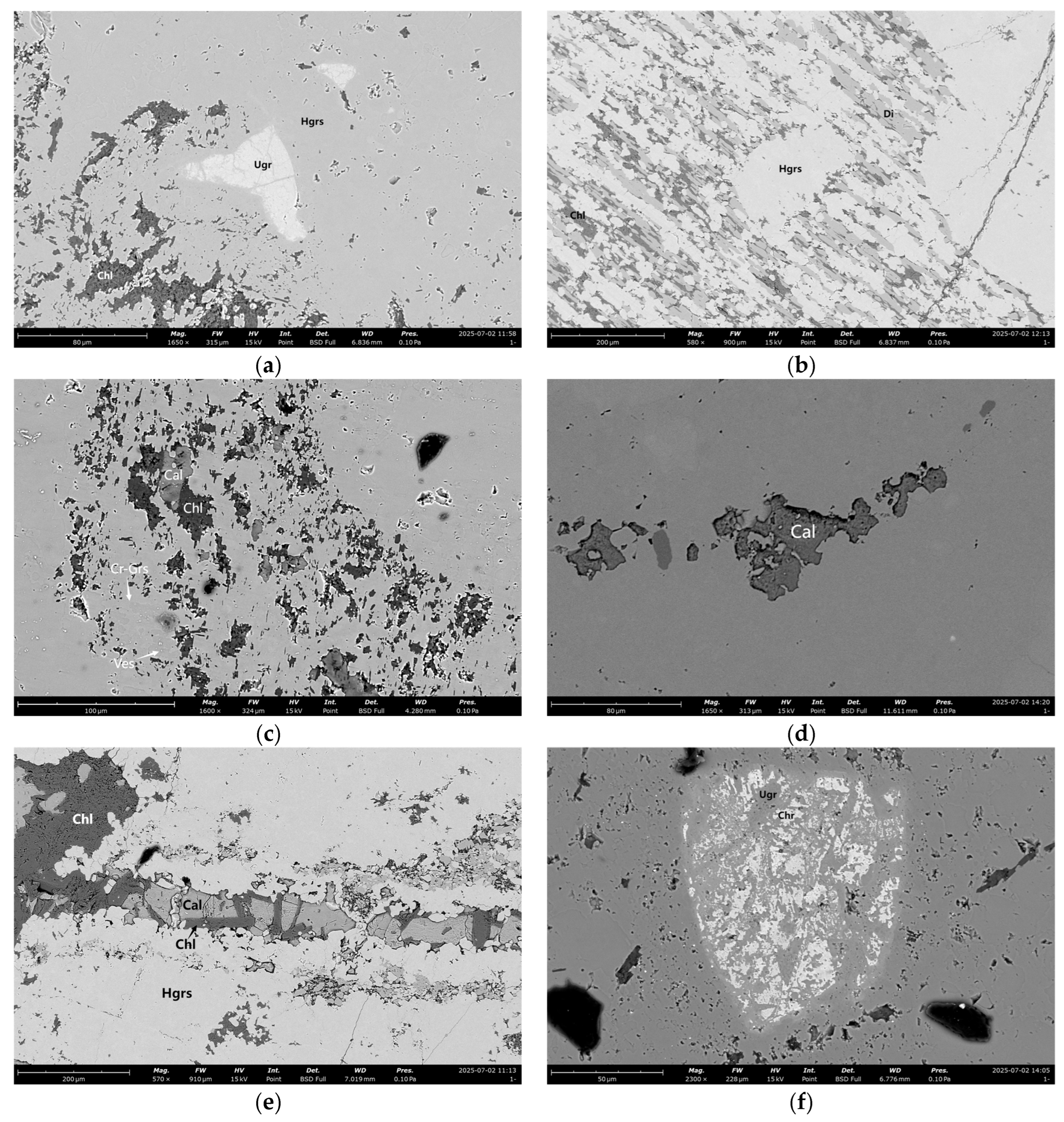
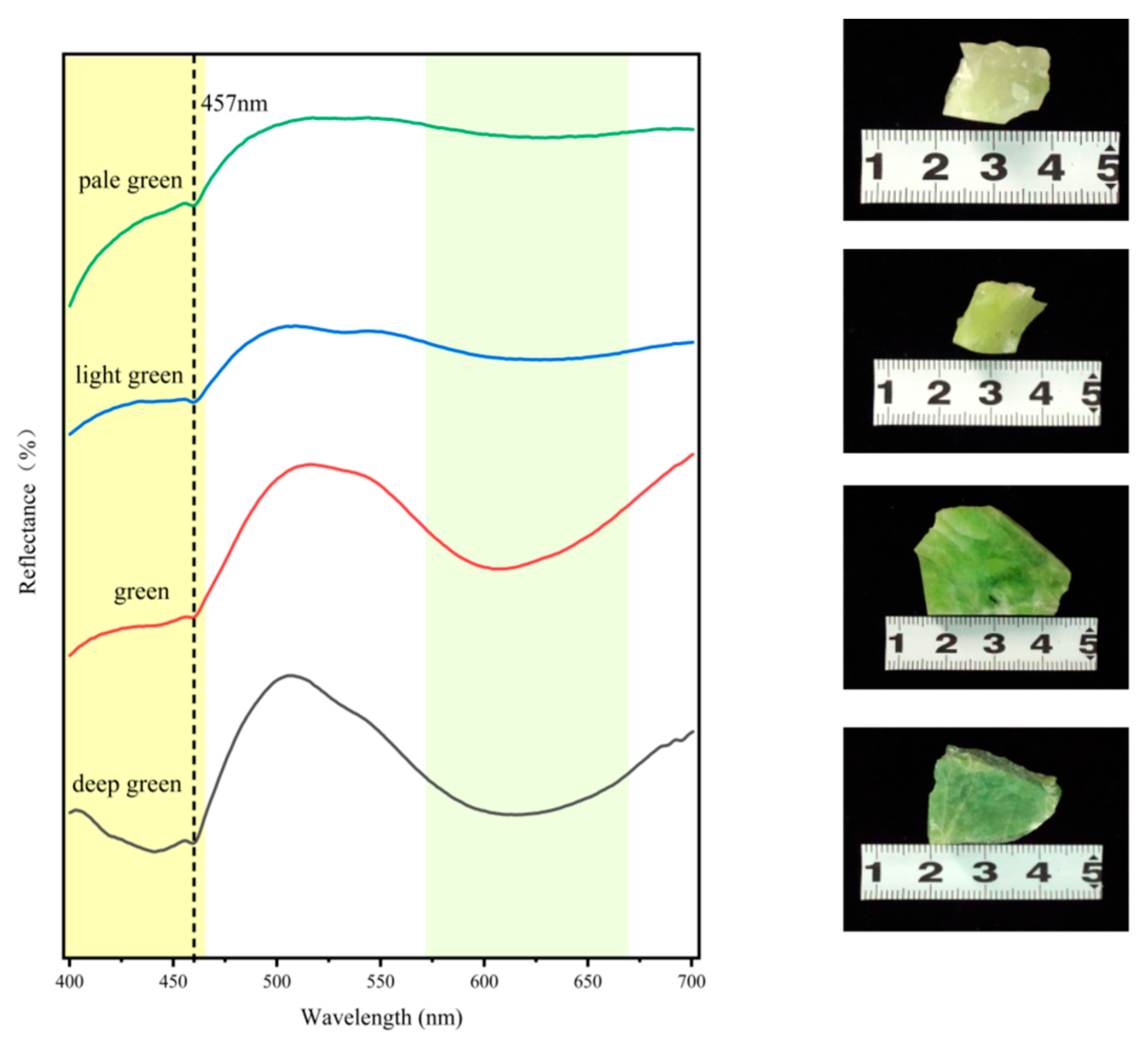


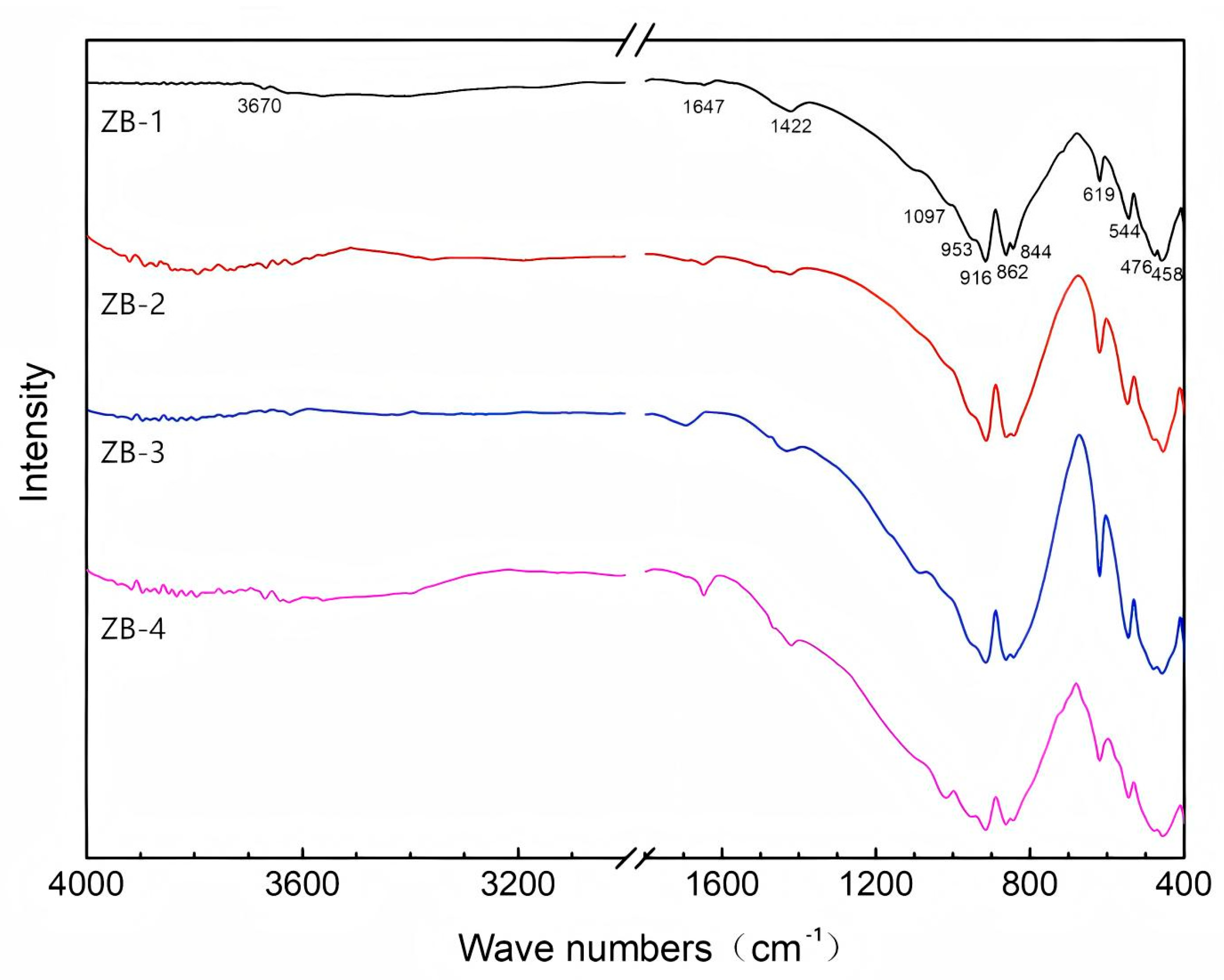
| Sample Number | Color | Refractive Index | Specific Gravity | UV Fluorescence (LW/SW) | Chelsea Filter Response |
|---|---|---|---|---|---|
| ZB-1 | Yellowish-green | 1.71 | 3.44 | None | Turns red |
| ZB-2 | White | 1.72 | 3.53 | None | Light red |
| ZB-3 | Light green | 1.72 | 3.54 | None | Light red |
| ZB-4 | Dark green | 1.71 | 3.40 | None | Turns red |
| (hkl) | ZB-3 | Phase Identification | PDF#79-1267 Grossular Ferroan | PDF#87-1119 Vesuvianite | ||||||
|---|---|---|---|---|---|---|---|---|---|---|
| 2θ | d (Å) | I% | 2θ | d (Å) | I% | 2θ | d (Å) | I% | ||
| (400) | 30.122 | 2.9644 | 33.8 | Grossular | 30.143 | 2.9623 | 37.7 | |||
| (432) | 32.595 | 2.7449 | 6.5 | Vesuvianite | 32.523 | 2.7508 | 100 | |||
| (420) | 33.78 | 2.6512 | 100 | Grossular | 33.802 | 2.6496 | 100 | |||
| (224) | 34.46 | 2.6004 | 2.7 | Vesuvianite | 34.419 | 2.6035 | 37.3 | |||
| (522) | 34.634 | 2.5878 | 3.1 | Vesuvianite | 34.561 | 2.5931 | 56.1 | |||
| (332) | 35.481 | 2.5279 | 7.3 | Grossular | 35.505 | 2.5263 | 6.3 | |||
| (620) | 36.643 | 2.4504 | 2.5 | Vesuvianite | 36.543 | 2.4569 | 40.8 | |||
| (422) | 37.118 | 2.4201 | 16.7 | Grossular | 37.14 | 2.4187 | 20.2 | |||
| (431) | 38.697 | 2.3250 | 16.6 | Grossular | 38.716 | 2.3238 | 13.2 | |||
| (521) | 41.697 | 2.1643 | 14.2 | Grossular | 41.716 | 2.1634 | 12.1 | |||
| (440) | 43.135 | 2.0955 | 3.6 | Grossular | 43.152 | 2.0947 | 2.6 | |||
| (611) | 47.222 | 1.9232 | 24 | Grossular | 47.247 | 1.9222 | 19.1 | |||
| (620) | 48.535 | 1.8742 | 1.6 | Grossular | 48.552 | 1.8735 | 1.4 | |||
| (444) | 53.516 | 1.7109 | 17.2 | Grossular | 53.536 | 1.7103 | 12.9 | |||
| (640) | 55.881 | 1.6439 | 23.2 | Grossular | 55.909 | 1.6432 | 22.5 | |||
| (642) | 58.197 | 1.5839 | 39.6 | Grossular | 58.217 | 1.5834 | 36.1 | |||
| (800) | 62.641 | 1.4818 | 8.7 | Grossular | 62.671 | 1.4812 | 8.2 | |||
| Sample | Crystal System | Axis a (Å) | Unit Cell Volume (Å3) |
|---|---|---|---|
| ZB-3 | Cubic | 11.493(5) | 1518.099 |
| PDF#79-1267 Grossular ferroan | Cubic | 11.849 | 1663.585 |
| Sample | Matrix | Emerald-Green Spots | Dark GreenSpots | ||||
| Date | ZBJ-1(Hgrs) | ZBJ-2(Ves) | ZBC-1(Ugr) | ZBS-1(Di) | ZBS-2(Chl) | ZBS-3(Hgrs) | |
| SiO2 | 37.54 | 35.26 | 35.18 | 53.54 | 23.06 | 35.27 | |
| Na2O | 0.00 | 0.04 | 0.07 | 0.05 | 0.04 | 0.05 | |
| TiO2 | 0.05 | 0.04 | 0.15 | 0.00 | 0.04 | 0.00 | |
| MgO | 0.14 | 3.26 | 0.05 | 19.10 | 30.90 | 0.06 | |
| K2O | 0.00 | 0.02 | 0.01 | 0.00 | 0.01 | 0.01 | |
| Al2O3 | 24.13 | 17.76 | 12.69 | 0.34 | 30.51 | 21.71 | |
| CaO | 36.41 | 38.13 | 35.98 | 25.34 | 0.03 | 38.75 | |
| Cr2O3 | 0.02 | 0.03 | 10.43 | 0.08 | 0 | 0.00 | |
| MnO | 0.01 | 0.09 | 0.09 | 0.04 | 0.06 | 0.00 | |
| Fe2O3 | 0.38 | — | 3.27 | 0.59 | 3.31 | 0.44 | |
| FeO | — | 1.62 | — | — | — | — | |
| NiO | 0.05 | 0.00 | 0.00 | 0.00 | 0.32 | 0.00 | |
| CoO | 0.00 | 0.00 | 0.02 | 0.00 | 0.04 | 0.00 | |
| Total | 98.73 | 96.25 | 97.94 | 99.08 | 88.32 | 96.29 | |
| Sample | MossyGreen Inclusions | Black Dot with a Green Ring | |||||
| Date | ZBX-1(Chl) | ZBX-2(Cr-Grs) | ZBH-1(Chr) | ZBH-2(Ugr) | ZBH-3(Ugr) | ZBH-4(Ugr) | |
| SiO2 | 26.01 | 35.80 | 0.44 | 34.17 | 33.92 | 34.18 | |
| Na2O | 0.08 | 0.07 | 0.19 | 0.05 | 0.04 | 0.06 | |
| TiO2 | 0.01 | 0.60 | 0.00 | 0.20 | 0.31 | 0.56 | |
| MgO | 31.44 | 0.44 | 2.41 | 0.04 | 0.06 | 0.13 | |
| K2O | 0.07 | 0.04 | 0.03 | 0.01 | 0.00 | 0.03 | |
| Al2O3 | 22.72 | 18.38 | 10.55 | 6.71 | 8.55 | 10.63 | |
| CaO | 3.77 | 35.14 | 1.31 | 35.13 | 35.12 | 35.03 | |
| Cr2O3 | 0.08 | 1.41 | 44.36 | 18.17 | 15.99 | 11.88 | |
| MnO | 0.07 | 0.38 | 1.35 | 0.16 | 0.17 | 0.17 | |
| Fe2O3 | 1.95 | 3.01 | 13.09 | 1.86 | 2.85 | 3.65 | |
| FeO | — | — | 26.21 | — | — | — | |
| NiO | 0.19 | 0.00 | 0.36 | 0.01 | 0.00 | 0.00 | |
| CoO | 0.08 | 0.02 | 0.24 | 0.01 | 0.02 | 0.00 | |
| Total | 86.47 | 95.25 | 100.54 | 96.52 | 97.03 | 96.32 | |
| Sample | ZB-1 | |
|---|---|---|
| Vibrational Mode Assignments | ||
| νas Si-O-Si Asymmetric Stretching Vibration | 1,097,862,844 cm−1 | |
| v3 Cr-OStretching Vibration | 619 cm−1 | |
| v2O-Cr-OBending Vibration | 544 cm−1 | |
| v1Fe-OStretching Vibration | 476 cm−1 | |
| Lattice Vibrations (Associated with Al3+ Vibrations) | 458 cm−1 | |
| ΝO-H Stretching Vibration | 3670 cm−1 | |
| δ O-H Bending Vibration | 1647 cm−1 | |
Disclaimer/Publisher’s Note: The statements, opinions and data contained in all publications are solely those of the individual author(s) and contributor(s) and not of MDPI and/or the editor(s). MDPI and/or the editor(s) disclaim responsibility for any injury to people or property resulting from any ideas, methods, instructions or products referred to in the content. |
© 2025 by the authors. Licensee MDPI, Basel, Switzerland. This article is an open access article distributed under the terms and conditions of the Creative Commons Attribution (CC BY) license (https://creativecommons.org/licenses/by/4.0/).
Share and Cite
Song, L.; He, M.; Zhang, Z.; Yang, L. Mineralogical and Gemological Characteristics and Color Genesis of Zibai Jade. Crystals 2025, 15, 871. https://doi.org/10.3390/cryst15100871
Song L, He M, Zhang Z, Yang L. Mineralogical and Gemological Characteristics and Color Genesis of Zibai Jade. Crystals. 2025; 15(10):871. https://doi.org/10.3390/cryst15100871
Chicago/Turabian StyleSong, Linhui, Mingyue He, Ziyun Zhang, and Ling Yang. 2025. "Mineralogical and Gemological Characteristics and Color Genesis of Zibai Jade" Crystals 15, no. 10: 871. https://doi.org/10.3390/cryst15100871
APA StyleSong, L., He, M., Zhang, Z., & Yang, L. (2025). Mineralogical and Gemological Characteristics and Color Genesis of Zibai Jade. Crystals, 15(10), 871. https://doi.org/10.3390/cryst15100871





